Soviet Nuremberg
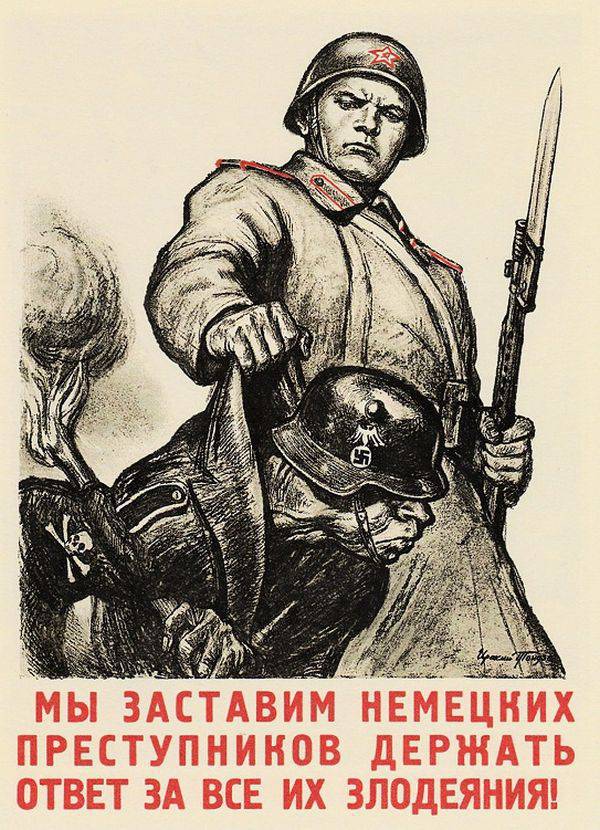
Goes to history 2015 is the seventieth year since the end of World War II. Hundreds of articles, documents, photographs dedicated to the holy jubilee, Rodina published this year. And we decided to dedicate the December issue of our "Scientific Library" to some of the results and long-term consequences of World War II.
Of course, this does not mean that, together with the jubilee year, the military theme will disappear from the pages of Motherland. The June issue is already planned, which will be devoted to the 75 anniversary of the beginning of World War II, analytical materials by prominent Russian and foreign scientists are waiting for their time in the editorial portfolio, letters about native veterans continue to arrive for the Home Archive column ...
Write to us, dear readers. In our "Scientific Library" there are still a lot of unfilled shelving.
Nazi open trial
The history of World War II is an endless list of the war crimes of Nazi Germany and its allies. For this, the main war criminals of humanity were openly judged in their lair - Nuremberg (1945-1946) and Tokyo (1946-1948). Due to its political and legal significance and cultural footprint, the Nuremberg Tribunal became a symbol of justice. In his shadow remained other demonstrative trials of the countries of Europe over the Nazis and their accomplices, and first of all open courts held in the territory of the Soviet Union.
The most brutal war crimes in 1943-1949 took place in 21, the affected city of five Soviet republics: Krasnodar, Krasnodon, Kharkov, Smolensk, Bryansk, Leningrad, Nikolaev, Minsk, Kiev, Velikiye Luki, Riga, Stalino (Donetsk), Bobruisk, Sevastopol, Chernigov, Poltava, Vitebsk, Chisinau, Novgorod, Gomel, Khabarovsk. 252 war criminals from Germany, Austria, Hungary, Romania, Japan and several of their accomplices from the USSR were publicly convicted on them. Open courts in the USSR over war criminals carried not only the legal meaning of punishing the perpetrators, but also political and anti-fascist. So they made films about meetings, published books, wrote reports for millions of people all over the world. Judging by the reports of the MGB, almost the entire population supported the prosecution and wished the defendants the most severe punishment.
On the demonstration process 1943-1949. the best investigators, qualified translators, reputable experts, professional lawyers, talented journalists worked. About 300-500 spectators came to the meetings (they no longer could hold rooms), thousands more stood on the street and listened to radio broadcasts, millions read reports and brochures, tens of millions watched newsreels. Under the weight of evidence, almost all the suspects confessed to the crime. In addition, only those whose fault was repeatedly confirmed by evidence and witnesses were on the dock. The sentences of these courts can be considered justified even by modern standards, therefore none of the convicts was rehabilitated. But, despite the importance of open processes, modern researchers know too little about them. The main problem is the inaccessibility of sources. The materials of each process were up to fifty extensive volumes, but they were almost never published by 1, since they are kept in the archives of the former KGB offices and are still not fully declassified. There is not enough culture of memory. In Nuremberg, in 2010, a large museum was opened, which organizes exhibitions and systematically examines the Nuremberg Tribunal (and 12 of the subsequent Nuremberg trials). But in the post-Soviet space there are no similar museums about local processes. Therefore, in the summer of 2015, the author of these lines created for the Russian military-historical society a kind of virtual museum "Soviet Nuremberg" 2. This site, which caused a great resonance in the media, collected information and rare materials about the 21 open court in the USSR 1943-1949.
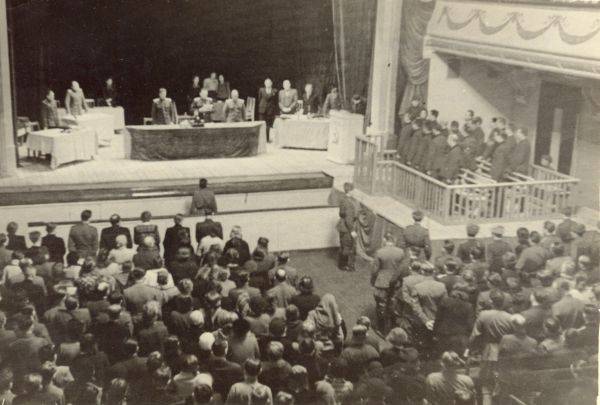
War Justice
Prior to 1943, no one in the world had any experience with the Nazis and their accomplices. In the world history there were no analogues of such cruelty, there were no atrocities of such temporary and geographical scales, therefore there were no legal norms for retaliation - neither in international conventions, nor in national criminal codes. Moreover, for justice, it was still necessary to free up crime scenes and witnesses, to capture the criminals themselves. The first to do all this could the Soviet Union, but also not immediately.
From 1941 to the end of the occupation, open courts were held in partisan detachments and brigades - traitors, spies, marauders. Their spectators were the partisans themselves and later the residents of the neighboring villages. On the front of the traitors and Nazi executioners, military tribunals were punished until the issuance of a decree N39 of the Presidium of the USSR Supreme Council of 19 on April 1943. from among Soviet citizens and for their accomplices. " According to the Decree, cases of the killings of prisoners of war and civilians were brought to the military field courts in divisions and corps. Many of their meetings, on the recommendation of the command, were open, with the participation of the local population. In the military tribunals, partisan, people's and military field courts, the defendants defended themselves, without lawyers. A frequent sentence was a public hanging.
The N39 decree has become the legal basis for systemic responsibility for thousands of crimes. Detailed evidence of the scale of atrocities and destruction in the liberated territories became the evidence base. For this, the “Extraordinary State Commission for the Establishment and Investigation of the Atrocities of the German Fascist Invaders and their accomplices and the damage they caused to citizens was created by decree of the Presidium of the Supreme Council collective farms, public organizations, state enterprises and institutions of the USSR "(CPP). In parallel, in the camps, investigators questioned millions of prisoners of war.
The open-ended 1943 processes of the year in Krasnodar and Kharkiv are widely known. These were the world's first full-fledged processes over the Nazis and their accomplices. The Soviet Union tried to provide a world outcry: foreign journalists and the best writers of the USSR (A. Tolstoy, K. Simonov, I. Ehrenburg, L. Leonov) covered the sessions, and cameramen and photographers took pictures. The entire Soviet Union monitored the processes - the reports of the meetings were published in the central and local press, and the reaction of the readers was also posted there. On the processes published brochures in different languages, they were read out loud in the army and rear. Almost immediately, the documentary films “The Verdict of the People” and “The Court Is Going” were released, they were shown by Soviet and foreign cinemas. And in the 1945-1946, the documents of the Krasnodar process about the "gas chambers" ("gas vans") were used by the international tribunal in Nuremberg.
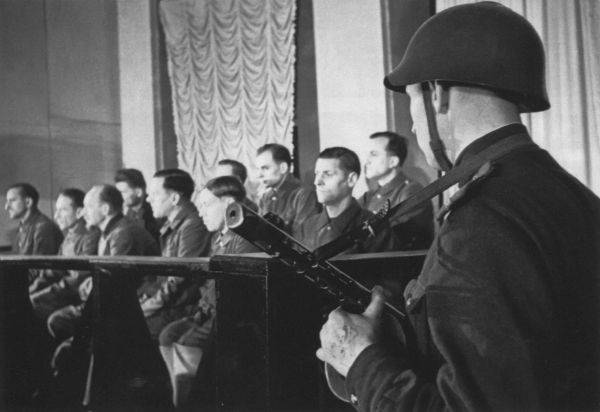
According to the principle of "collective guilt"
The most thorough investigation was conducted within the framework of ensuring open trials of war criminals at the end of 1945 - the beginning of 1946. in the eight most affected cities of the USSR. According to the directives of the local government, special operational investigative teams of the Ministry of Internal Affairs-NKGB were created, they studied archives, acts of CPGs, photo documents, interrogated thousands of witnesses from different regions and hundreds of prisoners of war. The first seven such processes (Bryansk, Smolensk, Leningrad, Velikiye Luki, Minsk, Riga, Kiev, Nikolaev) sentenced 84 war criminals (most of them were hanged). Thus, in Kiev, the hanging of twelve Nazis on Kalinin Square (now - Maidan Nezalezhnosti) was seen and approved by more than 200 000 citizens.
Since these processes coincided with the beginning of the Nuremberg Tribunal, they were compared not only to newspapers, but also to the prosecution and defense. So, in Smolensk, the public prosecutor L.N. Smirnov lined up a chain of crimes from Nazi leaders accused of Nuremberg to specific 10 executioners in the dock: "Both those and others are members of the same complicity." The lawyer of Kaznacheev (by the way, he worked at the Kharkov process) also spoke about the connection between the criminals of Nuremberg and Smolensk, but with a different conclusion: "Equal sign cannot be placed between all these persons" 3.
Eight Soviet 1945-1946 trials of the year were completed, and the Nuremberg Tribunal ended. But among the millions of prisoners of war there were still thousands of war criminals. Therefore, since the spring of 1947, as agreed by the Minister of the Interior, S. Kruglov, and the Minister of Foreign Affairs, V. Molotov, preparations have begun for a second wave of demonstrative trials against the German military. The following nine trials in Stalino (Donetsk), Sevastopol, Bobruisk, Chernihiv, Poltava, Vitebsk, Novgorod, Chisinau and Gomel, which were held by order of the Council of Ministers of September 10 of 1947, sentenced 137 people to terms in Vorkutlag.
The Khabarovsk 1949 process of the year over the Japanese developers of biological science became the last open trial of foreign war criminals. weaponswho tested it on Soviet and Chinese citizens (more on this on page 116 - Ed.). At the International Tribunal in Tokyo, these crimes were not investigated, as some potential defendants received immunity from the United States in exchange for these experiments.
Since 1947, instead of separate open processes, the Soviet Union began to massively conduct closed ones. Already 24 on November 1947 was issued by an order of the USSR Ministry of Internal Affairs, USSR Ministry of Justice, USSR Prosecutor’s Office N 739 / 18 / 15 / 311, which ordered the prosecution of war crimes in closed sessions of military tribunals of the Ministry of Interior troops at the location of the defendants (that is, practically without calling witnesses) without the participation of the parties and sentencing the perpetrators to imprisonment of labor camps for 25 years.
The reasons for the folding of open processes are not completely clear; no arguments have yet been found in the declassified documents. However, you can put forward several versions. Presumably, the conducted open processes were quite enough to satisfy the society, propaganda switched to new tasks. In addition, the conduct of open trials required high qualification of investigators, they were not enough in the field in the conditions of post-war personnel hunger. It is necessary to take into account the material support of open processes (the estimate of one process was about 55 thousand rubles), for the post-war economy these were substantial amounts. The closed courts made it possible to quickly and massively consider cases, sentence defendants to a predetermined term of imprisonment and, finally, corresponded to the traditions of Stalinist jurisprudence. In closed trials, prisoners of war were often tried according to the principle of "collective guilt", without concrete evidence of personal participation. Therefore, in 1990, the Russian authorities rehabilitated 13035 aliens convicted by war decree N39 for war crimes (for 1943-1952 in total. By decree, at least 81 780 people, including 24 069 foreign prisoners of war) 4 were convicted.
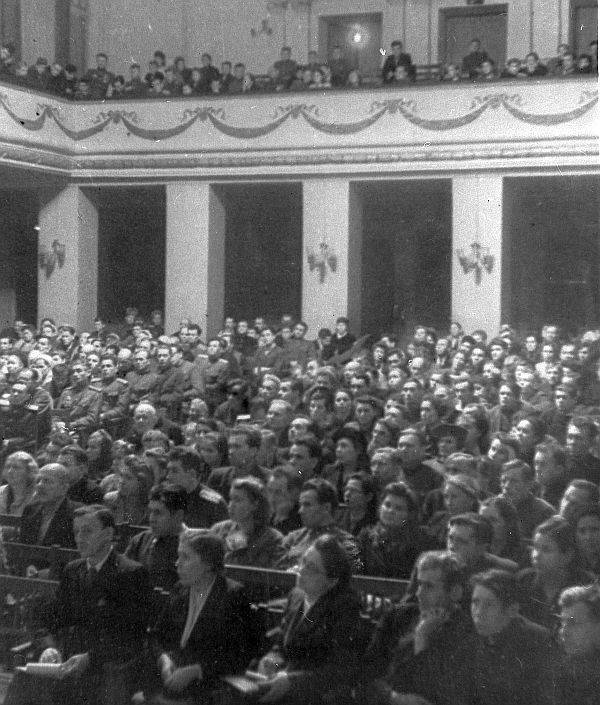
Statute of limitations: protests and disagreements
After Stalin’s death, all foreigners convicted in closed and open trials were handed over to the authorities of their countries in 1955-1956. This was not advertised in the USSR — residents of the affected cities, who well remembered the speeches of the prosecutors, clearly would not understand such political treaties.
Only a few who came from Vorkuta were imprisoned in foreign prisons (as was the case in the GDR and Hungary, for example), because the USSR did not send out investigative cases with them. There was a cold war, and the Soviet and West German justice agencies did not cooperate much in 1950. And those who returned to the FRG often said that they were slandered, and confessions of guilt in open trials were beaten out by torture. The majority of those convicted of war crimes were allowed by the Soviet court to return to civilian professions, and to some even to enter the political and military elite.
At the same time, part of the West German society (first of all, the young people who did not themselves catch the war) sought to seriously overcome the Nazi past. Under public pressure in the late 1950 in the Federal Republic of Germany open trial of war criminals took place. They identified the creation in 1958 of the Central Office of the Office of Justice of the Land of Germany to prosecute Nazi crimes. The main objectives of his work was the investigation of crimes and the identification of persons involved in crimes that can still be prosecuted. When the perpetrators are identified and it is established that they are under the jurisdiction of which prosecutor's office, the Central Office completes its preliminary investigation and transfers the case to the prosecutor's office.
Nevertheless, even the identified criminals could have been justified by the West German court. In accordance with the post-war Criminal Code of the Federal Republic of Germany, the statute of limitations should have expired for most of the crimes of World War II in the middle of the 1960s. Moreover, the twenty-year limitation period extended only to murders committed with extreme cruelty. In the first post-war decade, a number of amendments were made to the Code, for which war crimes perpetrators who were not directly involved in their execution could be justified.
In June, the "Conference of Democratic Lawyers" gathered in Warsaw, 1964, hotly protested against the application of statute of limitations to Nazi crimes. 24 December 1964 of the year with a similar declaration made already the Soviet government. A note from January 16, 1965, accused Germany of seeking to completely abandon the persecution of Nazi executioners. The same talked about the article, published in the Soviet editions of the twenty-year anniversary of the Nuremberg Tribunal5.
The situation seemed to be changed by the resolution of the 28 session of the UN General Assembly from 3 December 1973 of the year "Principles of international cooperation regarding the detection, arrest, extradition and punishment of perpetrators of war crimes and crimes against humanity." According to her text, all war criminals were subject to search, arrest, extradition to the countries where they committed their atrocities, regardless of the time. But even after the resolution, foreign countries extremely reluctantly handed over their citizens to Soviet justice. Motivating by the fact that the evidence of the USSR was sometimes shaky, for many years had passed.
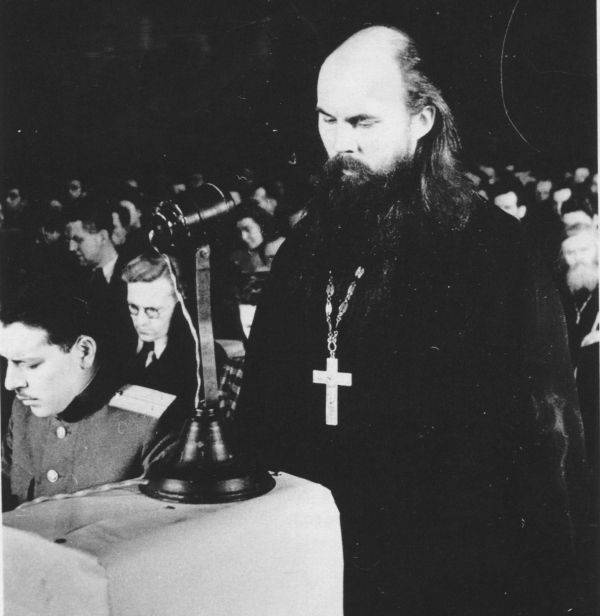
In general, due to the political obstacles of the USSR in the 1960-1980x years, it was not foreign war criminals but their accomplices who tried in open trials. For political reasons, the names of the punishers hardly sounded at the open processes of 1945-1947 over their foreign masters. Even the trial of Vlasov was held behind closed doors. Because of this secrecy, many traitors with blood on their hands were missed. After all, the orders of the Nazi organizers of executions were readily executed by ordinary traitors from ostbal'alons, game commands, and nationalist formations. So, at the Novgorod process 1947, the judge was Colonel V. Findisen6, the coordinator of the punitive from the Ostbatalona "Shelon". In December 1942, the battalion drove all the inhabitants of the villages of Bychkovo and Pochinok onto the ice of the Polist river and executed them. The punishers concealed their guilt, and the investigation could not link the cases of hundreds of executioners from Shelon to the case of V. Findizen. Without understanding, they were given general terms for the traitors and together with everyone they pardoned them in 1955. Punishers who disappeared where, and only then the personal fault of each was gradually investigated from 1960 to 1982 year on a series of open processes 7. It was not possible to catch everyone, but the punishment could have overtaken them in 1947 year.
There are fewer witnesses left, the already unlikely chance of a full investigation of the atrocities of the occupants and the holding of open courts is decreasing every year. However, such crimes do not have a statute of limitations, so historians and lawyers need to look for data and bring to justice all still-living suspects.
Notes
1. One of the exceptions is the publication of materials from the Riga Process from the Central Archive of the FSB of Russia (ASD NN-18313, T. 2. LL. 6-333) in the book Kantor Yu.Z. Baltic: war without rules (1939-1945). SPb., 2011.
2. For details, see the project "Soviet Nuremberg" on the website of the Russian Military Historical Society http://histrf.ru/ru/biblioteka/Soviet-Nuremberg.
3. The trial of the Nazi atrocities in the city of Smolensk and the Smolensk region, December 19 meeting // Proceedings of the Soviets of Workers of the USSR N 297 (8907) from 20 December 1945, c. 2.
4. Epifanov A.Ye. Responsibility for the war crimes committed on the territory of the USSR during the Great Patriotic War. 1941 - 1956 Volgograd, 2005. C. 3.
5. Voisin V. "Au nom des vivants", de Leon Mazroukho: une rencontre entre discours officiel et hommage personnel "// Kinojudaica. Les representations des Juifs dans le cinema russe et sovietique / dans V. Pozner, N. Laurent (dir.). Paris, Nouveau Monde editions, 2012, R. 375.
6. For details, see Astashkin D. Open trial of Nazi criminals in Novgorod (1947 year) // Novgorod historical collection. V. Novgorod, 2014. Issue 14 (24). C. 320-350.
7. Archive of the FSB in the Novgorod region. D. 1 / 12236, D. 7 / 56, D. 1 / 13364, D. 1 / 13378.
Information